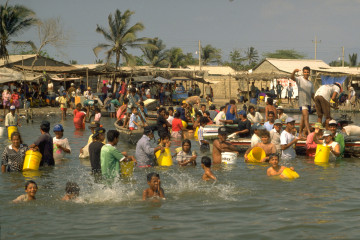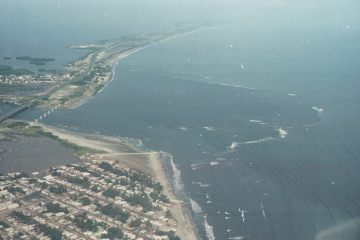To understand the responses of the plankton community to the negative large-scale human impacts in a tropical coastal lagoon complex, we carried out a regional survey on primary productivity (PP), community respiration (CR), and contribution of different size fractions of the phytoplankton to overall PP. This comparative study was undertaken in several coastal lagoons within the Outer Delta of the Río Magdalena (Colombia) during the dry season (February/March). PP was measured using the 14C-method with in situ-incubations and CR was determined as oxygen demand, using the Winkler technique. According to their salinities the lagoons were separated into a brackish water group (salinity range 5.9 – 21.8) and a freshwater group, the latter being influenced directly by the Río Magdalena. In all of the lagoons the productive layer did not surpass 1 m in depth due to selfshading by the high density of plankton (brackish lagoons) or due to high amounts of suspended inorganic sediment particles introduced into the freshwater lagoons from the Río Magdalena. The brackish lagoons contained high chl a concentrations (62 – 130 μg/l) and were extremely productive (0.72 – 1.25 mg C/l/h in the most productive depth, usually at 0.1 m). The concentrations of chl a in the freshwater lagoons were much lower (5.5 – 19 μg/l), also the PP (0.073 – 0.32 mg C/l/h). In all of the studied lagoons the photosynthetic active algae were very small, algae >20 μm (microalgae) played only a very insignificant role with respect to PP. The assimilation index (AI) was quite high (11.6 – 18.5 mg C/mg chl a /h). Only in two of the lagoons the relatively low AI (6.9 – 7.4 mg C/mg chl a /h) was probably due to senescent phytoplankton algae. The depth-integrated PP rates in the brackish lagoons ranged from 1.40 – 5.76 g C/m2/d. Especially the enormous rate of 5.76 g C/m2/d which was representative for the central part of Ciénaga Grande de Santa Marta demonstrated that this aquatic system belongs to the most productive ones world-wide. In the freshwater lagoons the daily PP measured 0.24 – 0.80 g C/m2. In the brackish lagoons the highly significant correlation between chl a and CR showed that the phytoplankton dark respiration was the dominant component, whereas the absence of a significant correlation in the freshwater lagoons demonstrated that here the heterotrophic microorganisms contributed more to community respiration. Only in three of the seven studied lagoons (among these Ciénaga Grande) planktonic primary production surpassed pelagic respiration, in the remaining four lagoons the deficit of organic material is probably compensated from allochthonous sources such as the mangrove fringes and/or river input.




